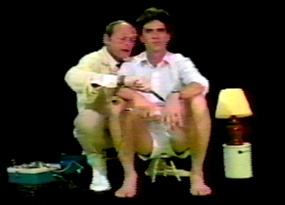Jerry Hunt: Bitom (fixture): topogram
 patient
performance requirement
patient
performance requirement
- Agent/patient must pair match: use same sex, same race, etc. Matches only
action requirement
- Bitom (fixture): topogram uses an impedance detection
system for location of impedance variations occurring on the surface of
human skin: the probe detection system is isolated form the sounding system;
the agent is electrically isolated from the patient; a low current circuit
is required for the impedance detection: this produces a sensation at the
point of probe placement
- The patient is placed in such a way as to allow the progression of the
scan pattern and associated mimetic transaction of the agent
- A focus scene placement is used for performance action
dress requirement
- The scan proceeds using topogram strategy tables: the arms, legs and
portions of neck, chest and back are partially exposed during the
performance scan action
- white cotton or linen only:
1. loose fitting long sleeve shirt with front buttons and loose fitting neck
2. loose fitting boxer or "athletic-style" shorts
performance action
- The performance is a transactional mimetic exercise using an exchange
procedure: agent/patient
- A series of three observation focus goals are required from the patient:
each focus goal observed calls in succession one of three reactive focus
procedures
- The agent/patient relation is always remote: no direct interaction other
than that specifically focussed through the goal string should be used
- Three categories of observation focus are requested serially from the
patient: upon the observation of this requested focus, one of three serially
required reactive focus procedures is requested
- The categories of observation and reaction focus are accessed in pairs
beginning at any point in [a] and [b]: each increment of [a] requires an
associated increment of [b]
 observation
focus categories
observation
focus categories
 |
~ |
wobble |
|
! |
close |
|
^ |
directive |
reactive focus procedures
 |
* |
diffuse |
|
+ |
focussed |
|
| |
remote |
- Jerry Hunt, 1992


Original Material Copyright © 1992 by Jerry Hunt. HTML Coding Copyright
© 2001 by Michael Schell.
All Rights Reserved.
 patient
performance requirement
patient
performance requirement
 patient
performance requirement
patient
performance requirement
 observation
focus categories
observation
focus categories![]()
![]()